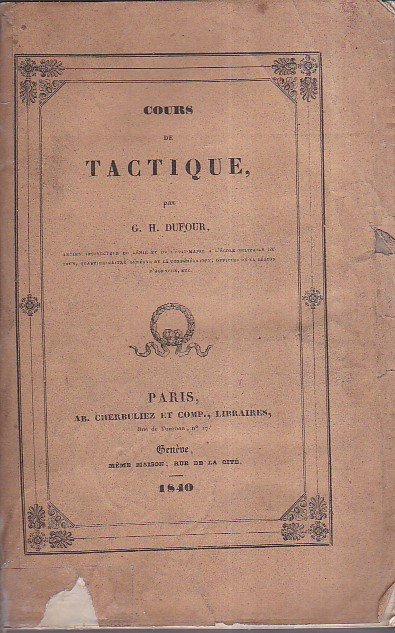Detalles
Autor
Dufour Guillaume Henri
Editores
Cherbuliez et C.
Materia
Militaria, Tattica bellica, Prime edizioni
Impresión bajo demanda
No
Descripción
In-8° (215x133mm), pp. VII, (1), 470, (1) di avviso al legatore, brossura editoriale marroncina con titolo entro bordura tipografica (velature restaurative al dorso). 21 tavole f.t. (molte ripiegate) di formazioni militari e schemi tattici. Fioriture. Qualche gora. Esemplare rifilato. Ex-libris di Cesare Maria De Vecchi di Val Cismon. Edizione originale di questo classico corso di strategia bellica, frutto delle lezioni tenute dal Dufour alla Scuola Militare di Thun, che egli stesso concorse a fondare nel 1819. '.Est le résumé des leçons que j'ai autrefois données à l'Ecole militaire de Thun. Il est principalement destiné aux officiers suisses, cependant ceux des autres nations y trouveront aussi quelques sujets d'instruction'. Il Dufour (Costanza, 1787-Ginevra, 1875), generale svizzero, 'served in Napoleon's army, defending Corfu in 1813 and taking part in the campaigns in France in 1814. He resigned in 1817 and returned to Switzerland, where he was appointed ingénieur cantonal, supervising the construction of public works that greatly improved Geneva. He also helped to form the military school at Thun in 1819, where he became chief instructor. Appointed chief of staff of the Swiss army in 1831, he commanded a division sent to restore order in Basel in 1833. In the same year, he began his pioneer topographical survey of Switzerland (published 184264). In 1847 Dufour was elected general of the federal army to act against the separatist confederation of Roman Catholic cantons known as the Sonderbund, and he displayed skill and moderation in its suppression. He was elected general for the second time in 1849 to maintain Swiss neutrality in the face of insurgents from Baden; again in 1857, during the conflict with Prussia over Neuchâtel; and finally in 1859, when the French were about to annex Savoy. He presided over the international congress in Geneva in 1864 that drew up the convention for the wounded in time of war and resulted in the creation of the Red Cross' (Encyclopaedia Britannica online). Interestingly his book appeared in an English language edition during the American Civil War, in a translation by Union officer William P. Craighill (New York 1864), and this was 'popular with Union officers during the war. [and] Craighill's translation [was chosen] for the study of the military art [at West Point] from 1873 through 1879, and it provided cadets with a primer for the army's intellectual framework of the battlefield' (Michael A. Bonura, Under the Shadow of Napoleon: French Influence on the American Way of Warfare from the War of 1812 to the Outbreak of WWII, NYUP, 2012, p. 153).


Descubre cómo utilizar
Descubre cómo utilizar

